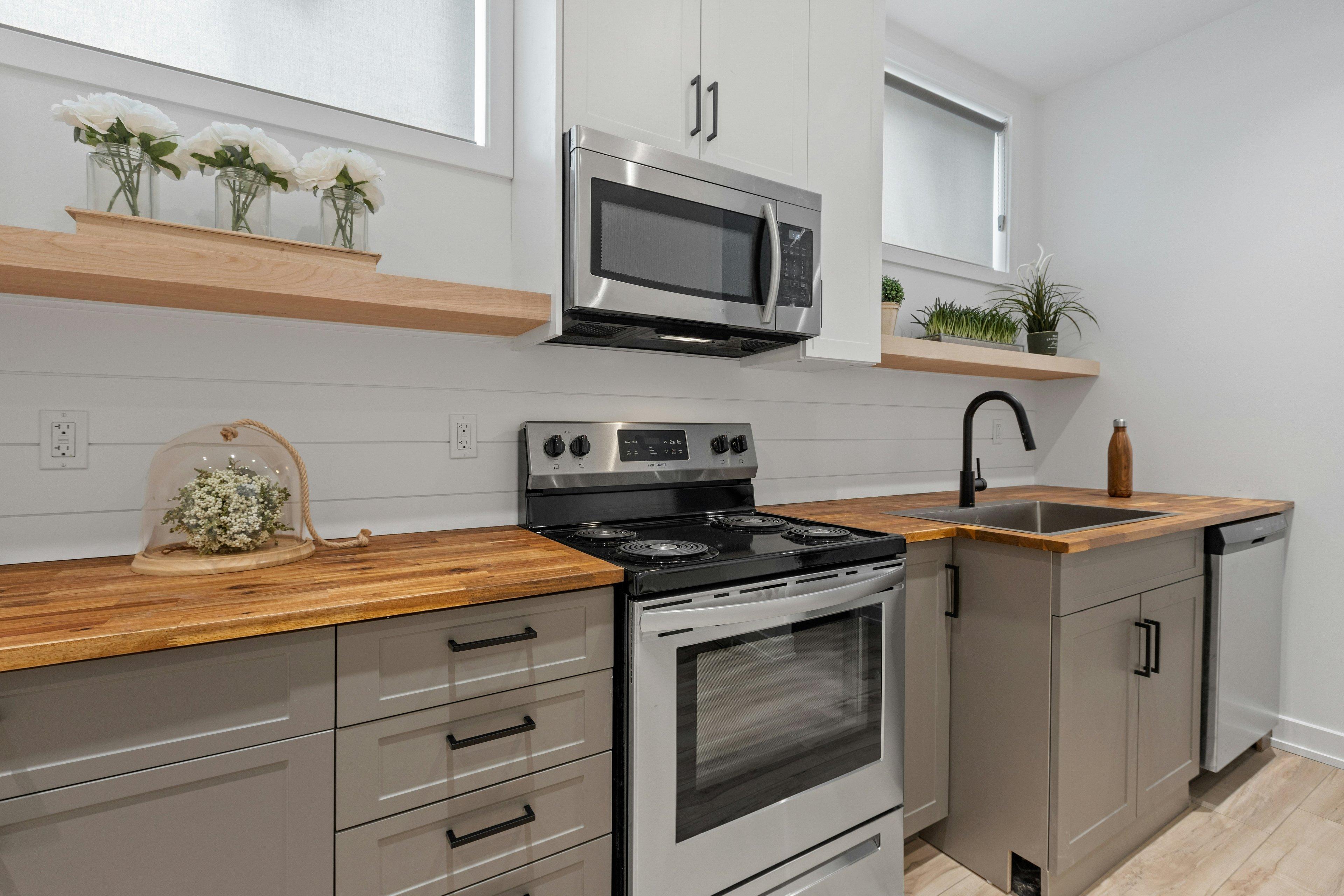Review
Main Parts of a Microwave You Should Know in Detail
AZparts Team
Updated on July 31, 2025
6 min read
The microwave is a familiar household appliance found in many homes, valued for its ability to heat and cook food quickly. However, not everyone fully understands how its internal and external components function. Gaining a clear understanding of the basic parts of a microwave not only helps you operate it correctly but also enables you to identify and address issues more easily when they occur. In this article, AZParts will guide you through the main parts of a microwave that you should know in detail.

1. Internal Microwave Components
1.1. Turntable
The turntable is a round glass plate located at the bottom of the microwave cavity, mounted on a rotating shaft and connected to the turntable motor. When the microwave operates, the plate rotates evenly, allowing the food to receive heat uniformly from all sides. This helps prevent uneven heating or overcooked spots. If the turntable does not spin, it could be due to misalignment, a faulty motor, or a jammed gear.
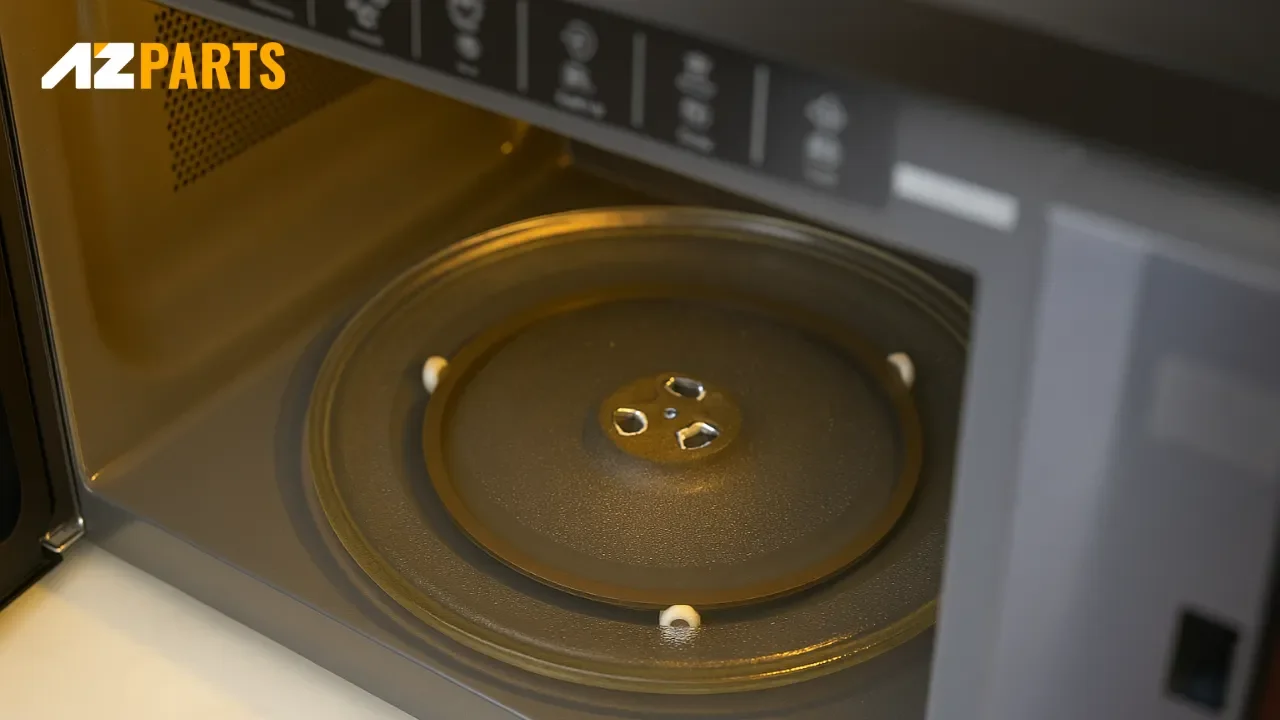
The turntable is a round glass plate located at the bottom of the microwave cavity (Source: AZParts)
1.2. Magnetron
This is one of the most essential components in a microwave as it produces the microwaves that heat the food. The magnetron uses high voltage electricity to convert electrical energy into high frequency electromagnetic waves. These waves cause water, fat, and sugar molecules in the food to vibrate, which generates heat. If the magnetron fails, the microwave may still light up and the turntable may continue to spin, but the food will not heat properly.
1.3. Voltage transformer
The transformer increases the standard household voltage from around 220 volts to several thousand volts to provide enough energy for the magnetron to operate. It also works with the capacitor and the diode to create a stable high voltage power supply circuit. This component can be dangerous if handled improperly, so it should only be checked or replaced by someone with proper technical expertise.
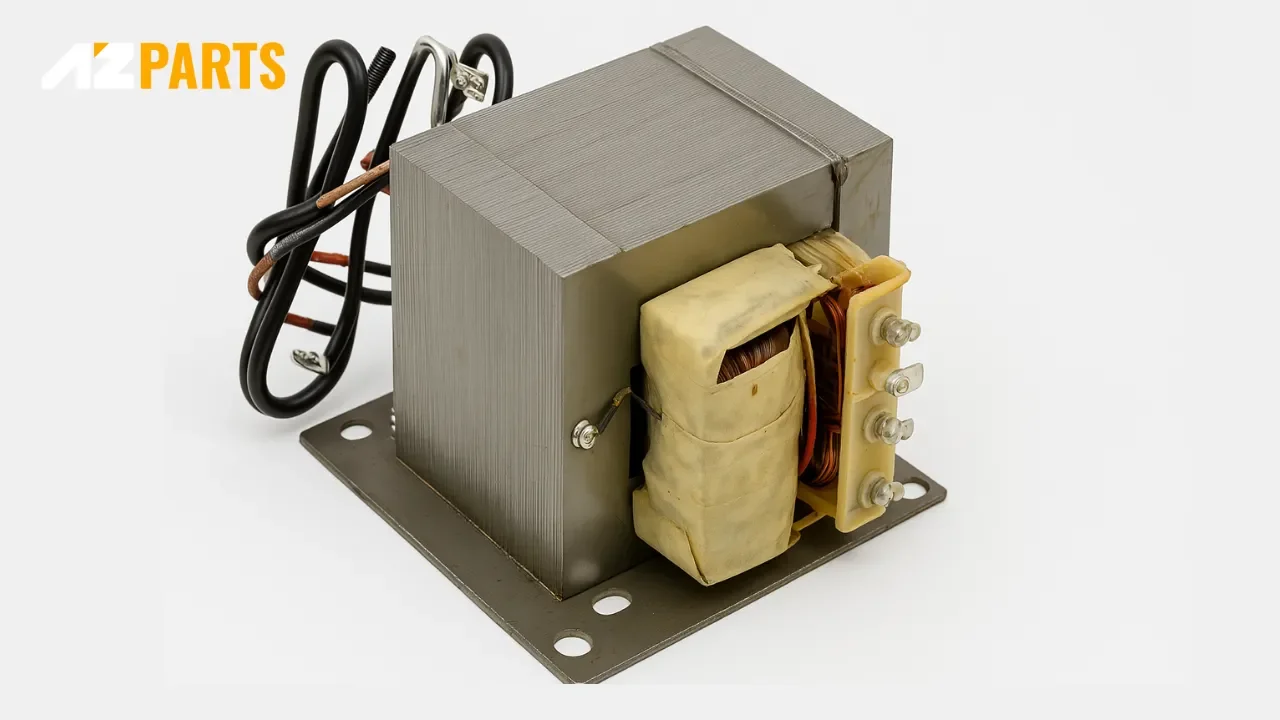
The transformer from around 220V to thousand volts to provide enough energy for the magnetron to operate (Source: AZParts)
1.4. Waveguide & cover
The microwaves generated by the magnetron are directed into the cooking cavity through a waveguide. A protective cover made of mica or metal shields the waveguide opening from steam, grease, and food debris. If the cover becomes scorched, moldy, or torn, it can cause sparking inside the microwave. In such cases, it should be cleaned or replaced immediately.
1.5. Cooling fan
The cooling fan is usually located near the magnetron and works to cool down heat-generating components such as the magnetron, capacitor, and transformer. If the fan fails to operate, the internal temperature can rise too high, leading to overload or damage to key parts. Since the fan runs almost continuously while the microwave is in use, any unusual noises or excessive heat may indicate a problem that requires inspection.

The cooling fan is usually located near the magnetron and works to cool down heat-generating components (Source: AZParts)
1.6. Cooking cavity
This is the interior space where food is placed during operation. The cavity is typically made of stainless steel or heat-resistant enamel and is tightly sealed to prevent microwave energy from leaking. Some high-end models feature nonstick coatings to make cleaning easier. If the cavity becomes rusty, heavily scratched, or cracked, it should be replaced to ensure safety.
2. External Microwave Components
2.1. Power cord
The power cord connects the microwave to the household electrical supply. It usually comes with a high-load plug to ensure stable power delivery to the entire appliance. If the cord is damaged, burnt, or the plug becomes loose, the microwave may stop working or pose electrical hazards. Using a high-quality cord that matches the required power rating is essential for safe operation.
2.2. Control Panel
This is where users select functions such as reheating, defrosting, setting time, adjusting power levels, and choosing automatic cooking modes. The control panel can be mechanical or touch-sensitive, depending on the model. Inside the panel is an electronic circuit that receives and processes user commands. If the panel becomes unresponsive or displays errors, the issue may be due to faulty buttons, a damaged control board, or moisture intrusion.
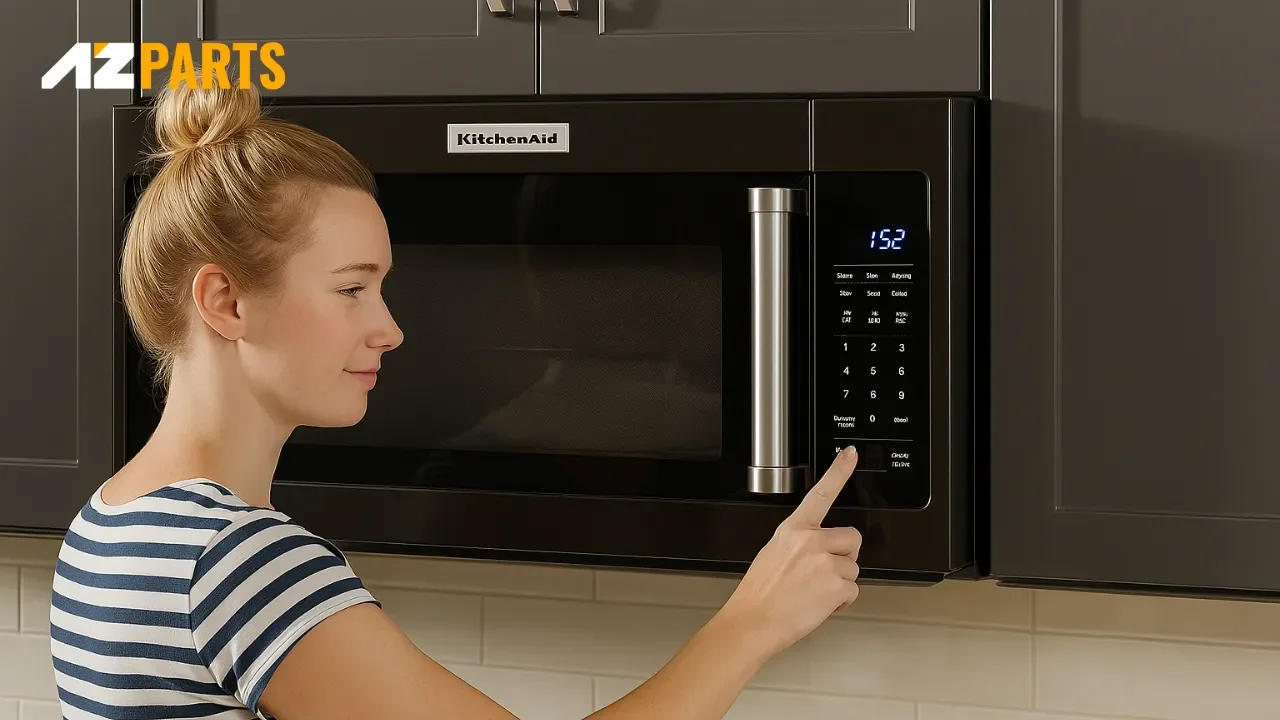
The control panel can be mechanical or touch-sensitive, depending on the model (Source: AZParts)
2.3. Door
The microwave door is specially designed to prevent microwave energy from escaping during operation. It typically consists of multiple layers of heat-resistant glass and a metal mesh to block microwaves. The door also includes safety locks and switches to ensure the microwave only operates when the door is fully closed. If the door is bent, cracked, or the handle is broken, it can compromise both functionality and user safety.
3. Microwave Parts by Type
3.1. Over-the-Range Microwave
An over the range microwave is installed above the cooking stove, helping save space while also functioning as a ventilation unit. In addition to the standard components found in regular microwaves, this type includes:
- Ventilation fan system: Helps extract and filter smoke and odors from the cooking area below. It can either vent air outside or recirculate it indoors through a filtering system.
- Grease filter and charcoal filter: Remove grease particles and cooking odors when the ventilation fan is running.
- Control panel located on the front or bottom: Depending on the design, it is positioned for easy access when the microwave is installed at a higher level.
- Mounting bracket and wall support frame: Securely fix the microwave to cabinets or kitchen walls.
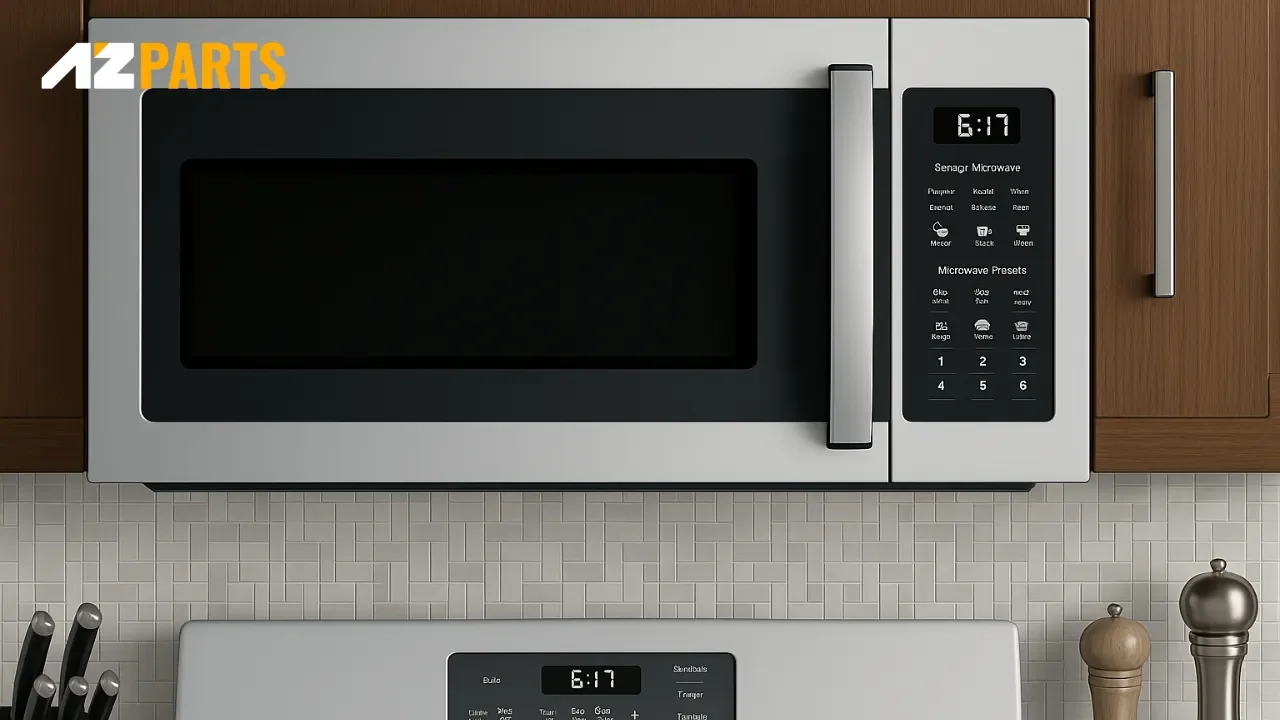
An over the range microwave is installed above the cooking stove, helping save space (Source: AZParts)
3.2. Built-In Microwave
A built in microwave is designed to be installed into a cabinet space or kitchen wall unit, creating a sleek and modern look. Key features include:
- Trim kit: A metal or plastic frame that surrounds the microwave for a seamless fit with the surrounding cabinetry.
- Front or side ventilation system: Unlike standard models, built in microwaves need efficient ventilation to prevent overheating in confined spaces.
- Reinforced frame structure: Helps the microwave stay securely in place and reduces movement during operation.
- Horizontal or vertical control panel: Positioned to be easily accessible when the microwave is mounted inside a cabinet.
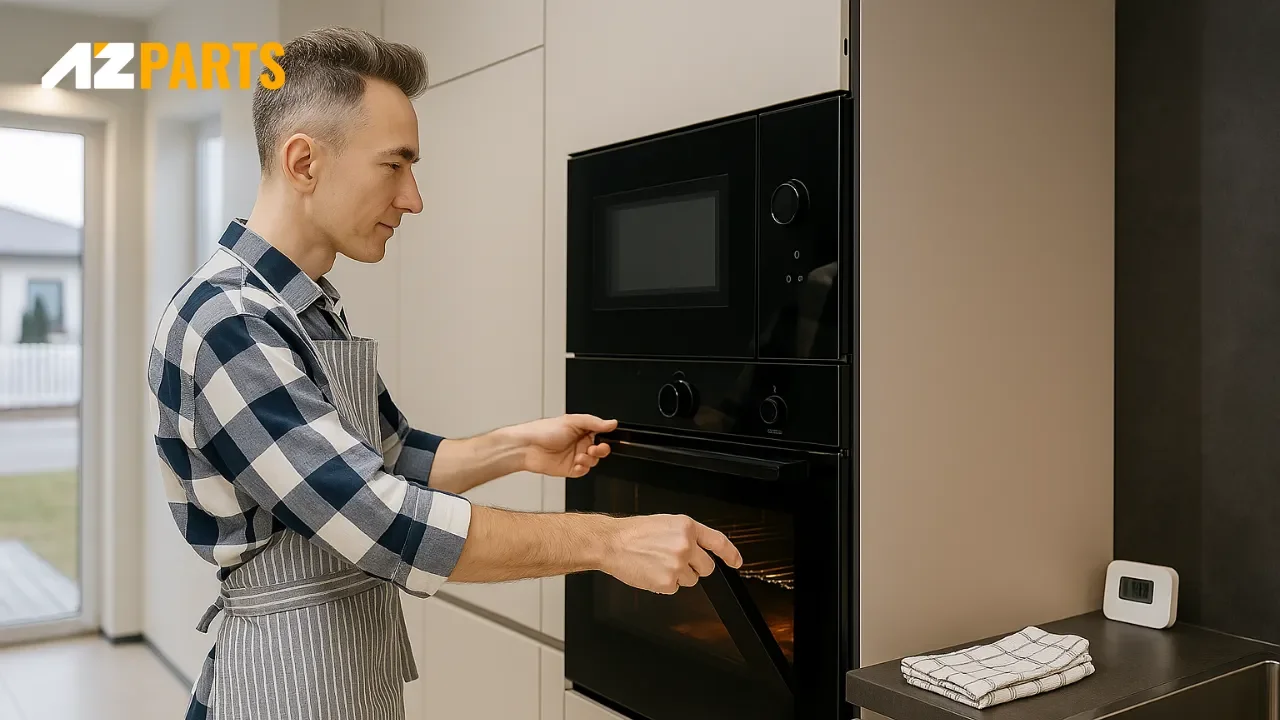
A built in microwave is designed to be installed into a cabinet space or kitchen wall unit (Source: AZParts)
4. Where To Buy Parts For a Microwave
When your microwave encounters a malfunction or needs a replacement part, finding high quality and compatible components is key to keeping it running safely and efficiently. You can easily find common parts such as microwave filters, charcoal filters, microwave glass plate turntables, turntable motors, light bulbs, door handles, or thermal fuses at AZParts – a trusted supplier of replacement parts for both residential and commercial microwave models.
AZParts offers a wide selection of parts compatible with many major brands including Sharp, Panasonic, Electrolux, LG, Samsung, Toshiba, and more. The store also provides support for identifying the correct part number and offers technical consultation if needed. Choosing the right replacement parts not only helps reduce repair costs but also extends the lifespan of your microwave and maintains optimal cooking performance.
Understanding the components of a microwave allows you to use the appliance more efficiently and troubleshoot issues quickly. Whether you own a countertop, built-in, or over-the-range microwave, identifying the right parts makes it easier to maintain or replace them when necessary.
Contact Info
Address: 8 The Green, Ste A, Dover, Delaware 19901-3618, United States
Email: support@azparts.com
Microwave
Further Reading
Further Reading




